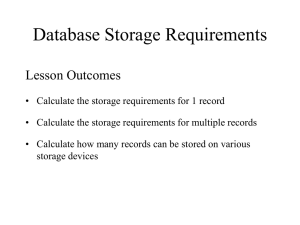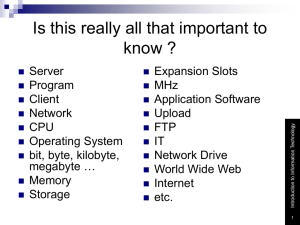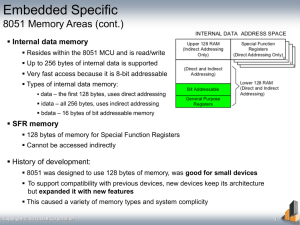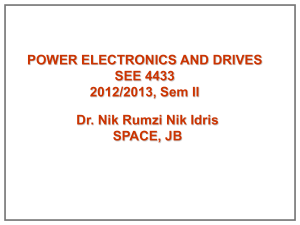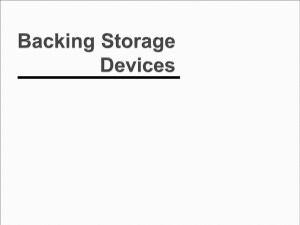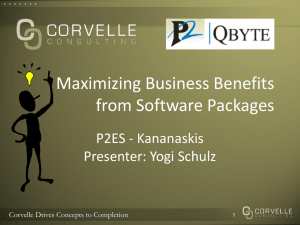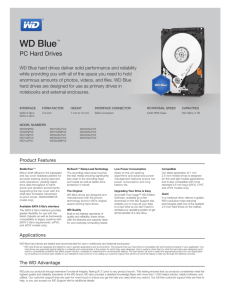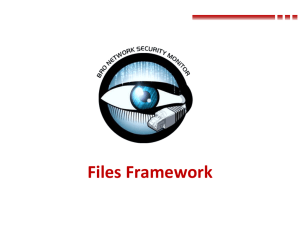Presentation
advertisement
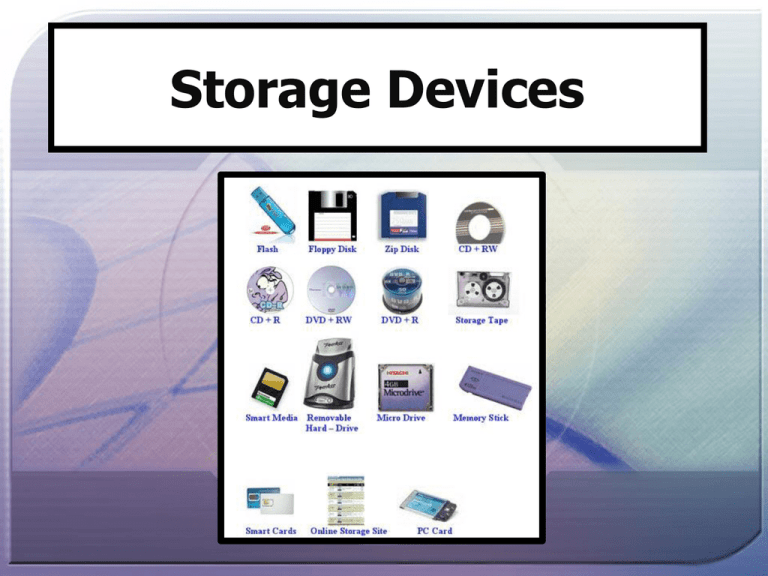
Storage Devices Intro •Most electronic devices need digital storage. • It is important to understand the differences in storage devices and file sizes before making a purchase. Objectives To understand File sizes To be able to mentally visualize file sizes To understand different storage devices To learn how to choose the right storage device for your needs To know the difference between read only and write Why is this important? Knowing this information will help you choose the right device for your needs. Knowing how many KB is in a GB, or how many MB is in a GB will help you in your decision making. Being able to visualize file size helps you to better understand the differences. File Sizes What is the difference in file sizes? File size measures the size of a computer file. This is typically measured in Bytes. Bits and Bytes…..delicious A BIT is the smallest increment of storage on a computer. Imagine each bit is like a light bulb. Each one is either on or off, so it can have one of two values (either 0 or 1). A BYTE is a string of 8 bits (eight light bulbs in a row). A byte is basically the smallest unit of data that can be processed on your family computer. Digital Measurements A KILOBYTE ( KB) is a unit of approximately 1000 bytes (1024 to be exact). Most download sites use kilobytes when they give file sizes. A Megabyte (MB) = 1,048,576 bytes or 1,024 kilobytes. Sometimes used to mean 1 million bytes Gigabyte (GB)= 1,073,741,824 Approximately 1 billion bytes (1024 MB). Most hard drive sizes are listed in gigabytes. Just Keeps Going A Terabyte = 1024 Gigabytes or 1,099,511,627,776 Bytes A Petabyte= 1,125,899,906,842,620 Bytes or 1024 terabytes An Exabyte= 1,152,921,504,606,850,000 Bytes or 1024 Petabytes A Zettabyte = 1,180,591,620,717,410,000,000 Bytes or 1024 Exabytes A Yottabyte is 1024 times a zettabyte! Wow! Simplify Technically a kilobyte is 1024 but most standards of measurement use 1000 bytes. This chart has exponential numbers, how does that work? To the Power of: Exercise Find the answer to the following: Answers Main Points Part 1 • Standard of measurement is Bytes • 1 Byte = 8 Bits • Kilo is a prefix meaning 1,000 base of measurement • Exponential numbers are the number times itself x amount of times Visual Representation Pt 2 •If we took each of these objects and imagined them to be hollow. •We are only thinking of the volume each will hold. A Bit ( A marble) 8 marbles would fit in a baseball A Byte ( A baseball) KiloByte ( a pick up truck) 1,000 baseballs in the area of a truck 1,000 trucks in a medium skyscraper MegaByte ( A med. Sized skyscraper) GigaByte ( 1024 Skyscrapers) TeraByte ( New York and Manhattan) To find out how many MB is in 500 GB, simply multiply 500 X 1000. This equals 500,000. So, 500 GB = 500,000 MB We do this because we know that a GB is 1000 MBs. To find how many GB = MB, we divide the number of MB by 1000. So, 800,000 MB divided by 1000 = 800. There are app. 800 GB to 800,000 MB. Measurement Size (bytes) Symbol Kilobyte 1,000 KB Megabyte 1,000,000 MB Gigabyte 1,000,000,000 GB Terabyte 1,000,000,000,000 TB Questions 1. There are 1,000 Bytes in a Kilobyte. How many bytes are in 6 KB? 2. There are 1,000 kilobytes in a Megabyte. How many KB are in 12 MB? 3. How many bytes are in 12 MB? 4. There are 1,000 MB in a gigabyte. How many GB are there if you have 365,000 MB? 5. How many KB are there in 6 GB? Answers 1. 1000 X 6 = 6000. So there are 6,000 bytes in 6 kilobytes 2. 1000 X 12 = 12,000. There are 12,000 KB in 12 MB 3. If there are 12,000 KB in 12 MB, and a KB is 1000 times a byte, then you multiply 12,000 X 1024 = 12,000,000 bytes. 4. You take the # of MB and divide by 1000 to get the number of GB. 365,000 / 1000 = 365 GB 5. This can be a simple 2 part multiplication problem. We know that a GB is 1000 times a MB. So we multiply 6 X 1000= 6000. So 6GB=6000 MB. A MB is 1000 times the size of a KB, so 6000 X 1000 = 6,000,000 KB Answer: 6 GB = 6,000,000 KB. Photography Project • Objective: Take original photos of objects in the room and outside to represent the following: • • • • 1 Bit 1 Byte 1 Kilobyte 1 Megabyte Arrange Photos • Use the provided template in Fireworks. • Place your pictures in the template • When finished go to File>Save As>choose .jpg • Upload your final picture to the gallery Applying Storage Amounts Pt 3 Physical Storage Vs. Digital Storage ?? A Typical Page of text is about 4 Kilobytes. 4 KB) An Amazon Kindle comes with 256 MB of internal storage, which only 180 MB is available. This can hold about 200 books. The average song is about 3,000 to 6,000 KB or 3 to 6 MB A CD holds about 650-700 MB. A 20 Gig hard drive will hold the same amount of info as 31 CDs! How Much is Enough • You want to purchase an MP3 player and there are many choices. • Your current music library has 4,253 songs, each 4MB in size. • What is the total size of all the songs? Music • The total amount is: 17,012,000 or a little over 17 gigs. • This will give us an idea of where we need to go with our purchase. • I would recommend a 32 gig player, 20 at the minimum. Pictures • You have an extensive photo library of 850 pictures, 8 megapixels and 3.2 MB each. • You want to purchase a flash drive so you need to know how big the current library is, report your answer. Photo Answer • The amount of the current library is: 2,720,000 or 2.7 GB. • If we purchased a 4GB drive we would have room to grow and they are very inexpensive. Differences in Storage Devices Pt 4 First, you must know the difference between Read Only and Read and Write. Read only Basically means that data is only able to be “read”. Data cannot be “written” , changed or deleted. Reading Writing Standard Cds and DVDs can be written to once, and then they become “ read only” Once you burn a Standard CD, you can no longer make changes to it. Flash Drives, External hard drives, Internal hard drives and SD Cards are read and write. You can add, erase and change data at will. Flash Drive Internal Hard Drive SD Cards External Hard drive Different types of storage devices: 1. CD’s (compact disks) 2. CD- RWs 3. DVDs 4. DVD- RWs 5. Flash Drives 6. External hard drives 7. Internal hard drives CDs CD-RW An optical disk used to store digital data. Most common media is audio. Cd’s hold about 700 MB of Data This basically means that the CD can be erased and re written to multiple times. DVDs DVD-RW An optical disk used to store digital data. Great for movies and video. DVDs hold about 4.7 GB. That would be app. 4800 MB This is about 7 times that of a CD! This basically means that the DVD can be erased and re written multiple times. Flash Drives Also called “ Jump drives”, “ USB Drives”, “ Thumb Drives”, “ Key Chain Drives” and more. These drives are removable and Rewritable. They are small in size and can hold between 64 MB to 64 GB. A USB drive does not require rebooting after it's attached, does not require batteries or an external power supply, and is not platform dependent. Several manufacturers offer additional features such as password protection, and downloadable drivers that allow the device to be compatible with older systems that do not have USB ports. External Hard Drives An external hard drive sits outside the main computer tower, in it’s own hard case. They are normally connected to your computer by a USB or Fire wire cable. External hard drives are compatible for multiple operating systems. External hard drives Pros: Have a larger storage capacity Longer life Generally holds about 500 GB and up Cons: These are usually larger in size Need an external power source Larger in Size Portable external hard drives do not require a power source. Pros: Normally quite small Easily portable Less expensive Cons: Usually hold smaller amounts of data They have a shorter life Fragile Internal Hard Drives An internal hard drive hold large amounts of information inside of the computers‘ structure. This is the primary storage of your computer. The hard drive is connected to the motherboard and must have a power source to work. They have the fastest transfer rate of all the storage devices. A typical internal hard drive stores between 320GB and 2TB Applying What you have learned. You need a storage device that is portable, able to read and write and can hold your music library that is about 2000 MB in size. What will you buy? Why? Applying What you have learned. Answer: You know that 2000 MB = 1.95 GB. I got this by dividing 2000 by 1000. Since flash drives are small, able to read and write, and can hold up to 64 GB, I would probably buy a flash drive with the storage space I am looking for. I could also buy a portable external hard drive to serve the same purpose. Generally, flash drives cost less.
